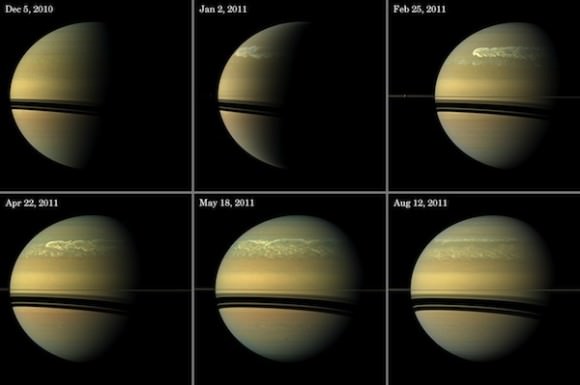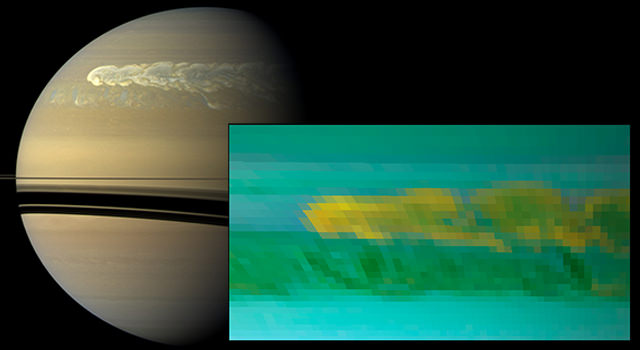Remember the huge storm that erupted on Saturn in late 2010? It was one of the largest storms ever observed on the ringed planet, and it was even visible from Earth in amateur-sized telescopes. The latest research has revealed the tempestuous storm churned up something surprising deep within Saturn’s atmosphere: water ice. This is the first detection of water ice on Saturn, observed by the near-infrared instruments on the Cassini spacecraft.
“The new finding from Cassini shows that Saturn can dredge up material from more than 100 miles [160 kilometers],” said Kevin Baines, a co-author of the paper who works at the University of Wisconsin-Madison and NASA’s Jet Propulsion Laboratory, Pasadena, Calif. “It demonstrates in a very real sense that typically demure-looking Saturn can be just as explosive or even more so than typically stormy Jupiter.”
While Saturn’s moons have lots of water ice, Saturn is almost entirely hydrogen and helium, but it does have trace amounts of other chemicals, including water. When we look at Saturn, we’re actually seeing the upper cloud tops of Saturn’s atmosphere, which are made mostly of frozen crystals of ammonia.
Beneath this upper cloud layer, astronomers think there’s a lower cloud deck made of ammonium hydrosulfide and water. Astronomers thought there was water there, but not very much, and certainly not ice.

But the storm in 2010-2011 appears to have disrupted the various layers, lofting up water vapor from a lower layer that condensed and froze as it rose. The water ice crystals then appeared to become coated with more volatile materials like ammonium hydrosulfide and ammonia as the temperature decreased with their ascent, the authors said.
“The water could only have risen from below, driven upward by powerful convection originating deep in the atmosphere,” said Lawrence Sromovsky, also of the University of Wisconsin, who lead the research team. “The water vapor condenses and freezes as it rises. It then likely becomes coated with more volatile materials like ammonium hydrosulfide and ammonia as the temperature decreases with their ascent.
Big storms appear in the northern hemisphere of Saturn once every 30 years or so, or roughly once per Saturn year. The first hint of the most recent storm first appeared in data from Cassini’s radio and plasma wave subsystem on Dec. 5, 2010. Soon after that, it could be seen in images from amateur astronomers and from Cassini’s imaging science subsystem. The storm quickly grew to superstorm proportions, encircling the planet at about 30 degrees north latitude for an expanse of nearly 300,000 km (190,000 miles).
The researchers studied the dynamics of this storm, and realized that it worked like the much smaller convective storms on Earth, where air and water vapor are pushed high into the atmosphere, resulting in the towering, billowing clouds of a thunderstorm. The towering clouds in Saturn storms of this type, however, were 10 to 20 times taller and covered a much bigger area. They are also far more violent than an Earth storm, with models predicting vertical winds of more than about 300 mph (500 kilometers per hour) for these rare giant storms.
The storm’s ability to churn up water ice from great depths is evidence of the storm’s explosive power, the team said.
Their research will be published in the Sept. 9 edition of the journal Icarus.
Sources: University of Wisconsin-Madison, JPL


I just wrote a block of quality and you lose it?
N.B. Your personal ‘theory’ was in violation of the 4th rule in Universe Today’s comment policy rules, which states:
Therefore, I have deleted your comments. If you have a problem with that, then talk to Fraser Cain.
Thanks disqus.
One last dogged attempt to comment via disqus. Oh my, water on Saturn! One of those gas giants? Plenty of water on their moons were told. Plenty of water out that way. But “gas giants” have but a trace of liquid water we’re told. They’re mostly hydrogen and helium, we’re told. I suppose any water has turned to steam? And the oxygen in H2o is where? Such BS. Every now and then I get a chance to try to educate the community to the possibility that the so called “gas giants” have significant, if not vast layers of water , also known as oceans; and that said oceans most certainly contain life, both micro and macro. And then disqus loses my message and I’m too angry to politely try to tell the moron world once again, that the “GAS GIANTS” have oceans rife with life. Shoemaker-Levy dredged up lots of water on Jupiter and now we see water ice on Saturn. Lightning on both “gas giants” most certainly water related. And you might be surprised to see how ignorant we are of the true state of P/T diagrams when the experts try to cross-section either of these huge, intricate, complex and colorful planets. I’m tired of being the lonely champion of life and oceans on the so called gas giants and welcome any discourse concerning such matters and wait to hear any info showing where I could be so wrong. I’ll try to transmit this agitated info now via this shoddy disqus crap.
Please, someone, convince me that there is no chance of finding oceans of liquid water on the gas giants, Jupiter and Saturn. Show me the math–I’ll try to grasp it. Show me your cross-sections however dogmatic, hypothetical, or senseless; I’ll try my best to understand. But I send caution–lifeforms can alter a planets physical layering and constitution as they have here on Earth.
Now that I can see my words are being posted, glory hallelujah, I can’t resist telling the world that their costly dreams of drilling and probing or even landing on Jovian moons seems a waste compared to insertion of an atmospheric balloon probe into the so called “GAS GIANTS”. I haven’t attempted the math but I’m betting 1/10 the cost, 10 x the survivability and longetivity.
Water on Saturn–surely you jest —water?–on a known gas giant? There’s no water out that way! Maybe a few liters but you experts and all your fools surely must know we’re talking about “gas giants”. Period. Discussion closed. Go to jail.
How delightful to think I’m being posted–thanks disqus. I hope this is my last post for the morning. I’ll give odds to you “gas giant” morons that both Jupiter and Saturn harbor lifeforms visible to the naked human eye. I’ll bet my dollar to your $128 dollars that I’m right and your not . Gas giant enthusiasts should welcome such odds. Let’s hope we live long enough to get verification. I’m serious about this bet –contact me if interested–I might give better odds but I know how sure you “gas giant” folk think you know there just can’t be any life on a gas giant protected by a huge magnetic field. Damn, I forgot to check Saturn’s field. Bet still stands.
“you’re”